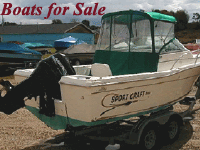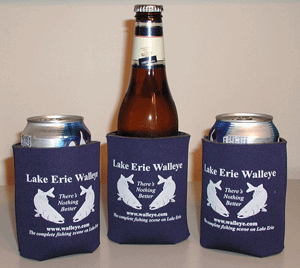Much debate has occurred over the years about fishing
and walleye
 activity
during the pre-spawn and spawning period. activity
during the pre-spawn and spawning period.
Unfortunately much of the information that has been passed along has
been based upon misinformation or just plain ignorance. Understanding
walleyes and the proper techniques to use during this period will help
you greatly improve your fishing success.
Many well intended anglers nationwide have questioned the ethics of
catching walleyes during the pre-spawn. Remember this: It doesn't matter
whether a female walleye is caught during this time period or in the
summer, the net effect is much the same. Simply put, provided that
anglers don't overharvest the key spawners, (the three to six pound
females) during any time period throughout the year, fishing pre-spawn
walleyes won't have a negative impact on your favorite fishery.
Always practice good conservation skills not only during this time
period, but through out the whole fishing year. Now let's get into
understanding this calendar period.
Walleyes spawn in rocky areas, instinctively seeking places that
receive large amounts of wave action which does two things: oxygenates
the eggs and keeps silt from covering them. These areas should be sought
out in the early spring on lakes, reservoirs and rivers. The spawn
begins when water temperatures reach 40 degrees and lasts until the
water warms beyond 45 degrees. In the period leading up to the spawn,
look around. You can use rip-rap, skull-sized rocks or other known
spawning areas as your points of reference when searching for pre-spawners.
The quickest and easiest way to find spawning areas is to simply ask.
Since walleyes spawn in the same locations year after year, someone will
know where the spawn occurs. If you can't learn this information at
local bait shops, contact the local conservation officer to put you on
the right track.
Pre-Spawn
Once the spawning area has been located the fish staging for the spawn
is easy to find with the help of a few simple rules. Begin at the
spawning area as walleyes spawn in the same area year after year.
Proceed from the spawning area and locate the closest 30-foot level of
water on the flattest bottom possible. Whether this depth is found in
the backs of bays or the bottom of the lake, 30 feet is the key. If the
lake doesn't have 30 feet of water, move to the closest, deepest part of
the lake and begin looking there.
The fish can be easily found and are unmistakable. On your
electronics, they'll mark as big hooks a foot or two off the bottom. It
may not be on a red-hot bite, so fish them with confidence and big
baits. Eventually a few will bite and two or three fish on any pre-spawn
day is considered a great day.
Once you have located the fish, move your boat to the up-wind side
and drift through them as slowly as possible. The best method for taking
pre-spawn fish is either Lindy rigging a large minnow four to six inches
long or vertical jigging with a 1/4 ounce to 3/8 ounce jig using a large
rubber body and a big minnow. My preference is both presentations at the
same time. Let the Lindy rig trail 75 to 100 feet behind the boat and
set the rod in a rod holder. Always keep an eye on the Lindy rig rod.
When a hit is made, open the bail and give the fish a good deal of line
and time before setting the hook. Remember these fish are somewhat
lethargic and you're using a large minnow, give them some time.
With the Lindy rig rod is in its holder, vertically jig with the
other rod. Jigging is easy - simply bounce the jig off the bottom,
keeping it as close to vertical as possible. Unlike the Lindy rig, set
the hook as soon as you feel a hit. For that matter, set the hook as
soon as you think you feel a hit.
One key to catching walleyes during the pre-spawn is to use big
baits. The young of the year haven't hatched yet, so the main food for
walleyes are the adult bait fish that have made it through the first
year and are now fully grown. Add the biggest body you have to your jigs
and cast or troll bigger crankbaits.
Slow Is The Key
Once you've located fish with electronics, remember fishing slow is the
key. For jigging or rigging, you can't go too slow. Use your bow mount
electric motor on the slowest speed. The slightest breeze will push you
fast enough. Use a sea anchor to slow you even more if there is any
wind.
Spawning
Walleyes spawn in water from one foot to over 20 feet deep. Rocky and
gravel covered shorelines are the most typical spawning sites; however,
if habitat is lacking walleyes will also spawn on sand and in other less
desirable areas. An abundance of broken rocks and gravel in water three
to 10 feet deep will normally attract the largest concentrations of
fish.
Reservoir walleyes typically migrate to the upstream end of an
impoundment to spawn. In large reservoirs, such as those along the
Missouri River, walleyes have been known to travel 100 plus miles to
reach prime spawning sites. Fisheries' biologists have tracked walleyes
tagged with radio telemetry transmitters from one end of Lake Oahe in
South Dakota to the other. Although this long distance may be an
isolated incident, walleyes are nomadic creatures that won't hesitate to
migrate many miles to find suitable spawning habitat.
Rip-rap shorelines near the dams are often prime spawning areas.
Trolling crankbaits along this rip-rap edge can prove absolutely deadly
on big fish. The best action usually takes place after dark and
continues until about midnight.
Although many walleyes prefer to spawn just downstream from dams, the
rocky shorelines and tributary streams also attract spawn-laden fish.
Not all the fish spawn at the same time or in the same places. This is
Mother Nature's way of ensuring that an entire "year class," those
particular fish that are born each year, isn't destroyed by floods or
other natural disasters.
Walleyes that spawn in rivers are the most predictable of all.
Clearly, 99 percent of the fish that enter the river to spawn will
physically swim as far as they possibly can before stopping to deposit
their eggs. Low head dams, waterfalls, or natural and man-made
diversions, usually stop the upstream movement of fish and often cause
the concentration of tremendous numbers of big fish in amazingly small
areas. At times, the walleyes will be so thick you can feel your lure
bouncing off the backs of the fish. Fishing under these conditions can
be easy and rewarding.
Walleyes that spawn in natural lakes are often the last fish of the
season to deposit their eggs. It usually takes a week or two longer for
the sun to warm these large inland lakes to the magical 40 to 45 degree
spawning temperature that walleyes prefer.
Trolling rip-rap areas
Troll the spawning areas with shallow diving crankbaits such as a Rebel
Minnow or Rattlin' Rogues. Trolling is by far the most effective method
I have found for taking spawning walleyes along rip-rap or rocky shore
lines. Long-lining crankbaits with eight to ten-pound test monofilament
line will produce the best results. Troll at a fairly brisk pace and use
a combination of long and short rods to stair-step lure depths to match
the angle of the structure. This will keep all your baits in the fish
zone.
Set the rods on the side of the boat closest to the rip-rap. Use a
long rod (eight to nine-foot) to reach out from the boat and present the
crankbait along the edge of the rocks. A shallow diving Rebel Minnow is
the ideal lure for the outside rod. The Rebel Minnow only dives two to
three feet, but that is enough to keep the lure ticking the stones near
shore. Next, set up a shorter rod with a slightly deeper diving lure
like the Rattlin' Rogue. Set an even shorter third rod with an even
deeper diving bait such as a Wally Diver or one of the new Shad-R baits.
By following this procedure, you'll effectively cover the sloping
rip-rap edges.
Water Temperature
In the spring, ignoring water temperature can be a costly mistake. Since
walleyes spawn in the same places every year at predictable temperature
levels, it is a simple matter to determine where the fish are in their
spawning cycle. You can tell by temperature if the fish are close to
spawning (pre-spawn) in the middle of it, or finished (post-spawn). This
information, in turn, gives you a general idea of where the fish will
be.
Peak Walleye Activity
Your best chances to catch a spawning walleye are definitely between
dark and midnight. The telemetry studies we've reviewed show a definite
trend with the majority of the fish arriving just at dark and spawning
until about midnight.
We've also found that fish spawn primarily for about four hours. One
fish might pull in and spawn for four hours and be done all in one
night. Another may come four different nights and spawn an hour each
night. In between these nightly visits, she'll make large movements,
sometimes up to five miles as the staging areas can be a long way away
from the actual spawning bed. Again, a key to big walleye success during
pre-spawn: "Be there at dark and don't stay any later than midnight."
|






 activity
during the pre-spawn and spawning period.
activity
during the pre-spawn and spawning period.